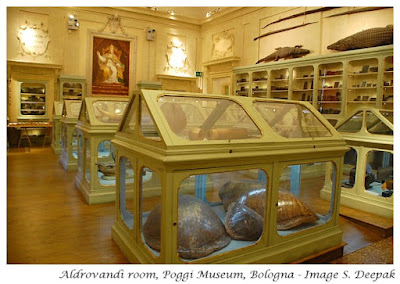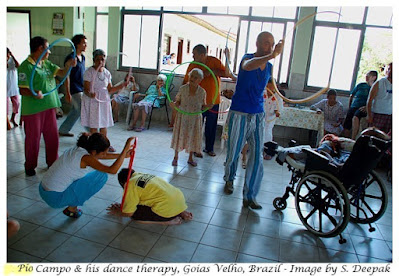I was curious to know, how did their cooks, who have an opportunity to observe their bosses in their private and personal moments, saw those monsters? I finished the 200 pages-long book in 2 days. The insight it gave me is the extreme banality of becoming dictators - ideology can blind people and make them do all kind of things which facilitates dictatorship!
Some Personal Background
Let me start with a confession - lately I seem to have become very weak-hearted. I can't watch any scenes of gory violence or the horror films. I also can't read any books about violence. Earlier, I was not so weak-hearted, but over the past few years, I just can't bear the feelings of dread such films/books can create.Thus, reading Szablowski's book was an unusual decision for me. I started reading it with the idea that if it had any graphic scenes of violence or torture, I would stop reading it. However, it does not go into the details of the deeds of those dictators. Most of the time, Szablowski only skims the surface, giving superficial accounts of the killings and the tortures.
During my travels around the world, I have been to many countries with communist regimes and some countries with dictators. Once, I even risked being taken prisoner by a group of communist guerrilla fighters. Listening to the stories of persons who had lived in these places, has cured me forever of the romantic ideas about revolutions and the charm of all kinds of ideologies such as communism and fascism.
I believe that violent struggle/revolution to fight against injustice and oppression is not a solution - it substitutes one kind of oppression and injustice with another kind, which is usually equally ferocious and implacable, and sometimes worse than what it replaces. Szablowsky's book has many stories about it.
Sometimes, I used to have long and animated debates with friends who believe in communism - I have learned to not argue with them. They are blinded by their beliefs and there is nothing I can say which can convince them otherwise. For example, I am sure that they can read Szablowski's book and find justifications for everything.
Dictators in Szablowski's Book
In his book Szablowski presents the stories of the cooks of 5 dictators - Saddam Hussein (Iraq), Idi Amin (Uganda), Enver Hoxha (Albania), Fidel Castro (Cuba) and Pol Pot (Cambodia).I already knew many things about all of them except for Enver Hoxha, the communist dictator of Albania. To read about him was a revelation. All the 5 protagonists of this book were paranoid personalities or perhaps, it would be better to say that once you become a ruthless dictator and are forced to kill people or to get them killed, you have no option but to become paranoid.
All the cooks of this book are men, except for the cook of Pol Pot. All of them, were associated with their bosses from their early carriers, before they had become the famous dictators. All were forced to become cooks because their bosses were suspicious of others and wanted someone they knew for this role. All of them walked on a tightrope, aware that their boss may suddenly feel that they are not faithful and decide to get them killed. Any dish cooked with too little or too much salt could have been seen as an attempt to poison.
The cooks' stories bring out the insecure men hiding behind the persona of ferocious dictator for whom they were working. Their stories bring out the specific personal traits of each of them, like Fidel Castro, who thought that he knew everything and gave long and boring lectures to everyone about how to do something, including to his cook. These parts of their stories give a comic touch to the book, even while in the background, the purges continue and the people surrounding the dictators fall out of favour and disappear.
The most fearsome person in the book is Pol Pot, also known as Brother Pouk or Brother Mattress or Angkar. He is fearsome because he is very handsome (according to his cook who sounds in love with him), always gentle and smiling. He is surprising because he is kind to his obviously mentally ill wife. He is fearsome because he believes completely in the teachings of Marx and Mao, and is willing to go to any length to realise his communist paradise - including killings of professors, doctors, writers and all the persons who have an education, and relocation of millions of city inhabitants to countryside so that they may learn the virtues of manual work and hunger. He is also most fearsome because he evokes obedience even from persons he has ordered to be killed. Even his cook who knows that she can never betray him, says that she would have been happy to be killed because "If Angkar has taken a decision, then he must be right".
I have never been to Cambodia, but I had heard many similar stories during my journeys in China and Vietnam in late 1980s and early 1990s.
Away from the cameras and the journalists, in their private lives, these mighty dictators were just little guys, missing the cooking of their mothers and their home towns, getting drunk, sometimes petty and sometimes generous, finding a refuge in their ideologies.
Conclusions
Sbzablowski's book does not make any new revelations but it gives a different point of view of seeing the infamous dictators of 20th century - persons who had made history and influenced their worlds. I felt sympathy for those cooks, who now try to hide behind ordinary lives, so that no one comes to look for them and to hold them responsible for those events, which took place when they were close to the powerful.Some of them, who had met kings, queens and prime-ministers and had cooked for them, travelled around the world in private jets and Mercedes cars, are now living lives of poverty, usually ignored by most regarding their illustrious past.






















